Abstract
The quality of red lettuce is based on the content of anthocyanin pigments, and the content of these pigments increases when the plant receives ultraviolet radiation. Lettuce crops are increasingly being grown in greenhouses to provide better quality fresh lettuce; however, both quality and productivity are affected by the type of cover used. The effects of UV-transparent and UV-blocking plastic films on the growth and quality of three lettuce cultivars (‘Casabella’ and ‘Vera’, which are both green leaf, and ‘Lollo Rosso’, which is red leaf) were investigated. The crop was cultivated at an altitude of 2576 m a.s.l. to naturally expose it to high ultraviolet radiation. The height and diameter of plants, fresh and dry weight, leaf area index, chlorophyll fluorescence, and leaf colour were determined throughout the crop cycle. Growth characteristics were not significantly influenced by the plastic film in all cultivars, probably due to the high altitude and the high solar radiation received. The UV-transparent film could increase the red colour in ‘Lollo Rosso’, and a higher commercial quality was achieved. No effect of the plastic film on the yield component was observed in the ‘Casabella’ and ‘Vera’ cultivars. The findings of this study provide guidance on what cultivar and plastic film must be used in high-altitude areas where the solar and UV radiation is high.
1. Introduction
Lettuce is a widely available crop and its production has increased worldwide, especially in the Mediterranean area and other regions such as Colombia, Brazil, and other Latin-American countries where crisphead, butterhead, romaine, batavia, and oakleaf are some of the most important types of lettuce grown for fresh or processed markets [1]. In these regions, lettuce crops are increasingly being grown in greenhouses or in polyethylene tunnels to extend seasonal availability and improve lettuce quality. Being grown inside a greenhouse helps with handling different environmental conditions, including radiation, temperature, humidity, and water and nutrient availability, providing a more favourable environment in comparison to an open field. In addition, the greenhouse crop system offers cleaner and higher quality crops, and in a shorter time. The radiation and temperature inside the greenhouse depend both on the incoming energy and losses through cover; therefore, the plastic cover has a crucial role in radiative and heat transfer mechanisms. The agricultural plastic industry has developed films with additives that prevent heat loss to the outside—namely, thermic plastics. These films are non-transparent to long-wavelength infrared radiation (particularly to 7 and 14 μm), allowing visible and short-wavelength infrared to heat up the soil, greenhouse structures, and plant contents inside. When the air temperature drops, usually at night, the heat is released from hotter objects as long-wavelength infrared and the temperature inside rises. Consequently, crops have an increased vegetative development, higher quality, and earlier harvests [2,3,4]. Moreover, the characteristics of some films favour better harvests and improve the health of the crop. Thus, films that block ultraviolet radiation avoid or prevent the sporulation of several phytopathogenic fungi; however, these plastic films can have adverse effects on fruit quality. UV-blocking films can be detrimental to pollination, since ultraviolet radiation is necessary for pollinator insects’ vision [5,6]. Another essential aspect is that ultraviolet radiation is required to initiate the violet colour in some ornamental and vegetable crops, such as eggplant and red-pigmented lettuce. [7]. Plastics contain additives with anti-UV components that block UV rays to address weathering from sources such as solar radiation and sharp temperature changes, thereby increasing plastic film durability. Problems occur when ultraviolet radiation is required for some physiological functions of plants, such as for the increased synthesis of anthocyanin pigments [8].
Despite the advantages of the greenhouse, its use is not widespread in lettuce growing and, as a result, there is not much knowledge of the effects of the greenhouse on physiological parameters and the quality of the lettuce head. Despite this, many other studies have been performed to assess the effect of UV radiation in plants growing under transparent surfaces or non-UV radiation. When the lettuce Dublin, an iceberg type, was grown in a greenhouse, it showed a significant growth response with enhanced yield components such as fresh and dry weight and leaf number, which were highly correlated with the increase in night temperature due to the effect of plastic [4]. In contrast, lettuce grown under plastic has shown a lower accumulation of phenolic and flavonoid compounds than lettuce grown in an open field, possibly because phenolic compounds are used by the plant as protective agents in stressful conditions such as low night temperatures [8]. Moreover, it is proposed that the lower growth of lettuce grown under clear plastic (without protective additives) could be due to the high UV radiation levels damaging the photosynthetic apparatus [9]. In this regard, it has been suggested that when lettuce is grown under a high level of ultraviolet radiation, it will contain more phenolic compounds because the plant will use flavonoids as a protective agent [10]. The use of UV-transparent films improves the nutritional quality in green types of lettuce due to the enhanced content of phenolic compounds [10]. Contrary to this finding, the cultivar ‘Lollo Biondo’, a green lettuce, did not increase its phenolic content in response to UV radiation, while ‘Lollo Rosso’ did [11]. The different response to UV radiation between red- and green-leaf lettuce could be attributed to changes in phenolic and other phytochemical contents, which are considered light-dependent [12].
In this study, we investigated the effect of two plastic films on the growth and quality of three different lettuce cultivars under greenhouse conditions; one film was UV-blocking and the other film was transparent to UV radiation. The experiment was carried out in Bogotá at a high altitude, 2576 m above sea level, so the crop naturally received a high level of ultraviolet radiation.
2. Materials and Methods
2.1. Plant Material and Growing Conditions
The experiment was performed in two greenhouses located at the experimental field of the Universidad Nacional de Colombia, Bogotá, 2576 m above sea level (latitude 4°38′17″ N, longitude 74°5′20″ W). Each greenhouse has an area of 27 m2 (3 × 9 m), with a height of 1.7 and 2.8 m in the gutter and ridge, respectively. The greenhouses were covered with a low-density polyethylene film with two different characteristics. The properties of the plastic film were determined according to the ASTM 1003 D standard: (i) transmissivities of 30% and 80% for diffuse radiation and total radiation, respectively; this film blocks UV up to 380 nm. (ii) UV-transparent film with a thermicity of 50% and transmissivities of 18% and 86% for diffuse and total radiation, respectively %. Figure 1 shows the spectral transmission of each plastic film used in this experiment.
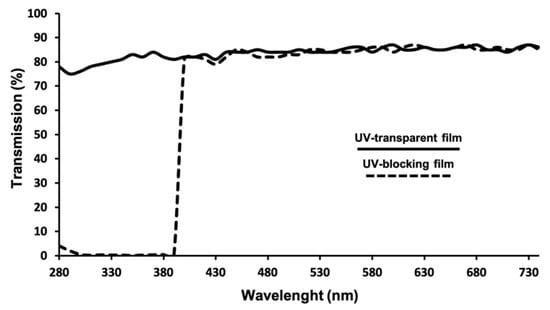
Figure 1.
Spectral transmission of the UV-transparent and UV-blocking polyethylene films used in this study.
Three lettuce cultivars (Lactuca sativa L.) were used, two of them belonging to the green leaf type (‘Casabella’ and ‘Vera’) and the third one belonging to the red leaf type (‘Lollo Rosso’).
The seeds were germinated in polystyrene seedling trays comprising 150 cells (30 × 35 × 75 mm each cell) filled with a commercial mix of sphagnum peat, perlite, and vermiculite. These trays were kept in a moist germination chamber at 25 °C. After germination, the seedlings were grown under controlled conditions for 25 days and then transplanted in the greenhouses. Then, in each greenhouse seedlings with similar heights and diameters were sown in an experimental plot consisting of 18 raised beds (0.6 × 1.50 m) corresponding to 3 cultivars and 6 randomly distributed repetitions. Each repetition had 10 plants spaced 25 cm between lines and 25 cm between plants. The substrate used in the beds was a mix of organic soil (80%) and burnt rice husk (20%) as a substrate. A standard nutrient solution whose composition in ppm was 165 N; 30 P; 250 K; 180 Ca; 40 Mg; 88 S; 0,3 Mn; 0,3 Zn; 0,1 Cu; 3 Fe; 1 B; 0,1 Mo was supplied.
2.2. Variables Analysed
2.2.1. Daily Mean Photosynthetic Active Radiation, Air Temperature, and Relative Humidity
Light intensity measurements were performed daily with an Extech® HD450 lux meter at three different times (07:00, 13:00, and 17:00). The data were processed to determine the photosynthetically active radiation (PAR) 400–700 nm; PAR was calculated after the transformation of the data from an Extech instruments ® HD450 lux meter according to Torres and López [13]. Air temperature (°C) and relative humidity (%) were continuously measured throughout the day during the crop cycle using Extech instruments ® RT10 data loggers (FLIR Commercial Systems Inc., Wilsonville, OR, USA.)
2.2.2. Height, Diameter, Fresh Weight, and Dry Weight
Three plants of each greenhouse, cultivar, and repetition were randomly sampled 7 days after planting (DAP), with up to 8 samplings sampled; the heights and diameters of the plants were determined. Fresh and dry weight were measured every 15 days after planting, using up to 4 samplings. The dry weight was measured after drying in a hot air oven at 60 °C for 48 h.
2.2.3. Leaf Area Index
Every 15 days, leaf area index (LAI) was estimated by the following formula:
where SA is the area covered by the plant and the leaf area was analysed using a leaf area meter (mod LICOR 360, LI-COR Inc., Lincoln, NE, USA).
2.2.4. Chlorophyll Fluorescence
The Chlorophyll a fluorescence transients of 30 min dark-adapted leaves were measured using a portable fluorometer (Handy PEA, Hansatech Instruments Ltd., Kings Lynn, UK). Chlorophyll fluorescence transients were induced by applying a pulse of saturating red light (peak at 650 nm, 3200 mmol m−2 s−1) and used to calculate the maximum quantum yield of PSII, according to Maxwell and Johnson [14,15].
2.2.5. Colour
Colour was measured using a compact tristimulus colorimeter Minolta CR-300 (Minolta, Osaka, Japan) to measure 20 leaves per cultivar; the sampling date was recorded. The hue angle [tan−1(b*/a*)] and chroma index [(a*2 + b*2)1/2] were determined from parameters L*, a*, and b*. According to Mcguire [16] and Marín et al. [17], the hue angle was represented on a 360° polar chart, where 0° and 360° represent red colour while 90°, 180°, and 270° represent yellow, green, and blue, respectively. The purity of the colour or saturation was expressed as chroma, where high values indicate a more vivid colour.
2.2.6. Anthocyanin Content
At harvest (8 weeks after sowing), the total anthocyanin content was measured by a UV-1601 Shimadzu UV–visible spectrophotometer (Shimadzu Corporation, Tokyo, Japan) at 530 nm absorbance wavelength. According to Islam et al. [18], the total anthocyanin was extracted in ethanol/HCl (85:15, v/v) at 4 °C. Anthocyanin content was estimated by applying the formula:
where AC is the anthocyanin content expressed in mg/100 g f.w.; A530 is the absorbance at 530 nm; Vex is the volume of extraction solution; Wsample is the weight of the sample; 98.2 is the molar absorptivity value for the acid-ethanol solvent.
2.3. Statistical Analysis
The experimental data obtained were initially checked by the Kolmogorov–Smirnov test to check the data normality. Then, relating to the quality and growth parameters of lettuce, a two-way analysis of variance (ANOVA) was performed, with the cultivar and film plastic being the two factors. Moreover, when the F-test from the ANOVA was significant, an LSD test was applied to compare the means. A separated one-way ANOVA was then performed separately within each cultivar to check in which film the plastic effect was significant. If significant differences were found, then the LSD post hoc test was applied. All the statistical analyses were performed using the Statgraphic Centurion XVI (STATGRAPHICS. Statpoint Technologies, Inc., Warrenton, VA, USA).
3. Results
Figure 2 shows the hourly temperature and relative humidity average inside the greenhouses as well as PAR radiation. No significant differences depending on the plastic sheeting were found for temperature and relative humidity. The temperature never dropped below 10 °C and the maximum temperature was never higher than 35 °C; the relative humidity was also similar in both greenhouses, with peaks near 90% during the night and a minimum of 37% in the hours of maximum illumination. The PAR values were around 175–225 μmol·m−2·s−1, and the PAR throughout the crop cycle was similar in both greenhouses, although it was slightly higher in the greenhouse covered by the UV-transparent film—the main value was approximately 10% higher (Figure 2).
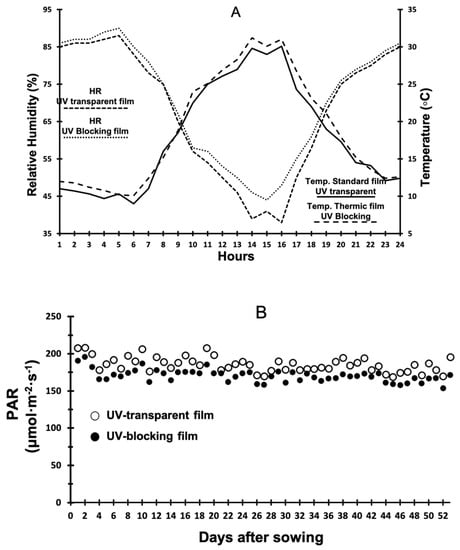
Figure 2.
(A) Hourly average air temperature (°C) and relative humidity (%) inside the greenhouses; data were taken through crop cycle. (B) daily photosynthetically active radiation (μmol·m−2·s−1).
Table 1 shows the main results related to the effects of plastic films and cultivars on the growth and quality parameters of lettuce. Both plastic film and cultivars offered significant differences in the quality parameters of colour and anthocyanin content. In relation to the growth parameters, only the diameter and photosynthetic efficiency had differences. The diameter in the ‘Vera’ cultivar was the one that stood out in comparison with the rest of the cultivars, whereas the photosynthetic efficiency did so in the ‘Lollo Rosso’ cultivar. In relation to the interaction between film plastic compared to cultivars, all the parameters of quality showed differences, as well as photosynthetic efficiency. Photosynthetic efficiency was the only growth parameter that showed differences, as it was noticeable in the ‘Lollo Rosso’ cultivar. The film plastic effects on the ‘Lollo Rosso’ cultivar were quite interesting, with a significant increase in the anthocyanin content for the UV-transparent plastic film compared to the UV-blocking film. Within this cultivar, the higher values of the hue angle parameter were present for the UV-transparent film crop. Finally, neither the ‘Casabella’ cultivar nor the ‘Vera’ cultivar showed differences in colour and anthocyanins content.

Table 1.
Growth and quality parameters of lettuce as affected by film plastic and cultivar.
The growth characteristics were not significantly influenced by the plastic film in all cultivars (Figure 3). In detail, eight weeks after sowing the diameter was higher in the cultivar ‘Vera’ (approximately 22 cm); ‘Casabella’ and ‘Lollo Rosso’ were also similar (approximately 17 cm). Likewise, no differences were found for plant height between the UV-blocking and UV-transparent film throughout the growing cycle. However, while there were differences between cultivars, all of them showed a similar height at the end of the crop cycle (Figure 3).
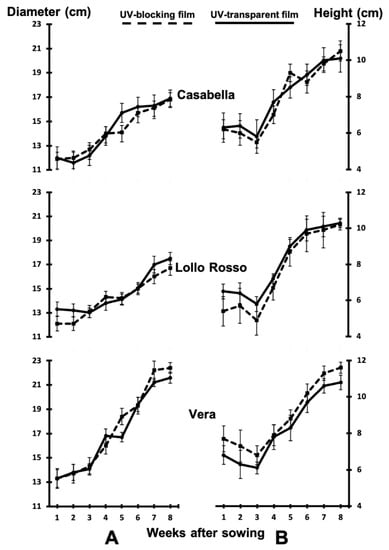
Figure 3.
Effects of plastic sheeting on diameter (A) and plant height (B) in three cultivars of lettuce. Vertical bars show standard error (SE) (n = 18).
The plastic film did not significantly influence the growth characteristics in all cultivars; however, differences between cultivars were found for lettuce head diameter (Table 1). Thus, from the fourth week of sowing until harvest, the ‘Vera’ cultivar showed a larger diameter. Specifically, at the time of harvest the diameter of the ‘Vera’ cultivar was approximately 5 cm larger than that of the other cultivars. Likewise, no differences were found for plant height between the UV-blocking and UV-transparent films throughout the crop cycle; however, although there were differences between cultivars for diameter, all the cultivars showed a similar height at the time of harvest (eight weeks after sowing) (Table 1 and Figure 3).
Throughout the crop cycle, the dry matter content increased gradually in all the cultivars. The first phase was found where growth was slow; the growth rate increased from the fourth week after sowing. As of the second week, after sowing and up to the end of the experiment, the dry matter content sharply increased in all cultivars, although it was in the cultivar ‘Vera’ where a greater dry weight was reached at eight weeks after sowing. At harvest time (eight weeks after sowing), the ‘Casabella’ cultivar showed a higher dry weight in plants grown under UV-transparent film. A similar pattern was followed by fresh weight; no differences between sheeting were found during the four first weeks after showing. At harvest time in the ‘Lollo Rosso’ and ‘Casabella’ cultivars, the fresh weight was greater in plants grown under UV-transparent film; these plants showed a weight close to 29% higher than plants grown under UV-blocking film. In contrast, the fresh weight in the ‘Vera’ cultivar was only slightly greater than 10% in plants grown under this type of plastic film (Figure 4).
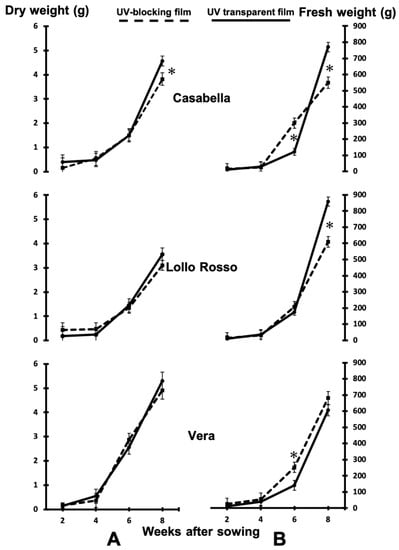
Figure 4.
Effects of plastic sheeting on dry (A) and fresh weight (B) in three cultivars of lettuce. Vertical bars show SE (n = 18). * indicates significant differences within each cultivar between UV-transparent and UV-blocking films according to LSD test at p < 0.05. No symbol indicates no differences.
Figure 5 shows the effect of the two types of plastic film on the LAI and photosynthetic efficiency parameters. No differences were found between sheeting in all cultivars for LAI. This parameter increased throughout the crop cycle in all cultivars, but the increasing pattern was different in each cultivar. In ‘Lollo Rosso’, the LAI increased sharply from 0.5 and 0.8 to 5 and 5.6 for UV-transparent and UV-blocking film, respectively. In ‘Vera’, the increase was more gradual and of a lesser extent (from 0.5 and 0.6 to 3 and 2 for UV-transparent and UV-blocking film, respectively). The LAI in Casabella displayed a pattern halfway between ‘Vera’ and ‘Lollo Rosso’; the LAI gradually increased until six weeks after sowing and, from that moment on, began to sharply increase. In fact, during the last two weeks the LAI values in ‘Casabella’ approximately increased by more than 40%. With respect to photosynthetic efficiency, differences between cultivars were found. In ‘Lollo Rosso’, the Fv/Fm ratio was significantly lower than the rest of the cultivars (Table 1). In this cultivar, differences between plants grown under different films were significantly lower in plants grown under UV-transparent film. Throughout the crop cycle, the Fv/Fm values remained above 800; this value is generally considered normal, although a slight decrease for ‘Lollo Rosso’ at eight weeks after sowing was found. This cultivar shows significant differences between plastic films. A higher value was found for the UV-blocking film (Figure 5).
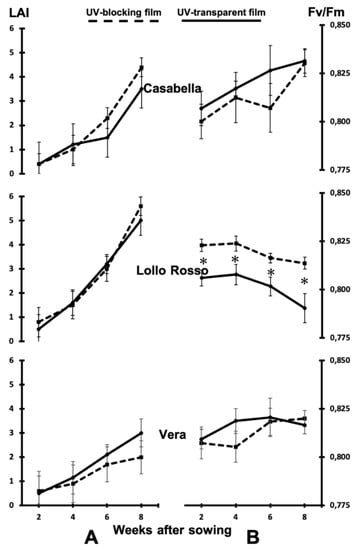
Figure 5.
Effects of plastic sheeting on the leaf area index (LAI) (A) and photosynthetic efficiency (B) in three cultivars of lettuce. Vertical bars show SE (n = 18). * indicates significant differences within each cultivar between UV-transparent and UV-blocking film according to the LSD test at p < 0.05. No symbol indicates no differences.
To determine the influence of film on the colour of lettuce, the data of the colorimeter were combined and analysed (Figure 6). The lowest hue angle value was shown by ‘Lollo Rosso’ grown under the UV-blocking film; the highest hue angle value was recorded when this cultivar was grown under UV-transparent film, these data indicated that the ‘Lollo Rosso’ grown under UV-transparent film showed the reddest colour. On the contrary, in the ‘Casabella’ and ‘Vera’ cultivars, the hue angle values were similar for both cultivars without differences between films. ‘Casabella’ and ‘Vera’ showed a lower dispersion for hue angle values; this meant that these cultivars showed a more homogenous colour during the crop cycle, whereas ‘Lollo Rosso’, with a higher dispersion, showed more heterogenous coloration. ‘Lollo Rosso’ showed the lowest chroma values (about 10), whereas ‘Casabella’ and ‘Vera’ had the highest values (more than 20), with no significant differences between both cultivars. Moreover, these two cultivars showed significant differences between plastic films. In ‘Vera’, significant differences were found only at harvest (eight weeks after sowing), whereas for ‘Casabella’ significant differences were found at the middle and the end of the crop cycle (Figure 6).
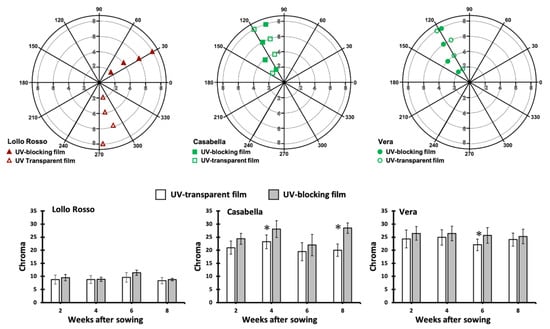
Figure 6.
Hue angle vs. sampling week (polar plot) and chroma values vs. sampling week (bars chart) of three cultivars of lettuce. Vertical bars show SE (n = 18). * indicates significant differences within each cultivar between UV-transparent and UV-blocking films according to LSD test at p < 0.05. No symbol indicates no differences.
The reddish colouring of the lettuce corresponds to the data obtained by the colourimeter and to the anthocyanin content of the plants. Table 2 shows that the anthocyanin content depends on the variety and is influenced by the increased UV radiation received. As expected, given its red variety ‘Lollo Rosso’ had a much higher content than the other varieties, even when grown under UV-blocking plastic, as shown in Figure 7A slight increase in the anthocyanin content, although significant, was found in the ‘Casabella’ and ‘Vera’ cultivars when they were grown under UV-transparent film.

Table 2.
The effect of plastic film on the anthocyanin content in three cultivars of lettuce at harvest (eight weeks after showing). Expressed in mg/100 g fresh weight.
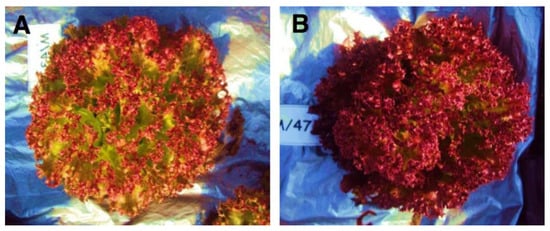
Figure 7.
The general appearance of Lollo Rosso at harvest grown under UV-blocking film (A) or UV-transparent film (B). Note the difference in quality in the lettuce head.
4. Discussion
Growth rate and other growth parameters are closely associated with a plant’s ability to intercept light. However, other environmental parameters also exert their influence; the most important are light and temperature, which are strongly affected by plastic sheeting. In our study, no differences were found between plants grown under UV-blocking and UV-transparent films (except in fresh weight at the end of the crop cycle). These results contradict the data previously reported by Semida et al. [4] in 2013, who found that the iceberg lettuce cultivar Dublin showed significant growth when it was grown under UV-blocking films. This was because the yield component (dry weight, fresh weight, and leaf number) and night temperature are positively correlated, but in our study the night temperatures were similar in both greenhouses (Figure 2). Moreover, the PAR radiation under both plastics was very similar, which decisively contributed to the growth and was almost comparable in both greenhouses; differences appeared only at the end of the growing cycle. Although the transmissivity of the diffused radiation was different in both plastic films (18% and 30%), it was not a limiting factor to the crop due to the high solar radiation received at the 2700 m altitude. The importance of diffuse radiation on gross primary productivity in ecosystems has been well documented [19,20]. Other studies have noted the relationship between plastic sheeting and diffuse radiation [21,22]. Diffuse light penetrates deeper into a plant canopy while direct light does not, resulting in greater growth, especially in a high solar irradiation environment as in our case, since the experiment was carried out in Bogotá plateau (high altitude and latitude 4º north), where the incident solar radiation is greater as it is nearer the equator where the sun is vertically above for more hours in the day and more days of the year. Although the previously mentioned authors point out [21,22] that the growth response of plants to diffuse radiation is season-dependent, their studies were performed in northern temperate latitudes characterised by strongly marked seasons; our study was carried out in a tropical latitude where there are no marked seasons. Lettuce is sensitive to high light levels; Fu et al. [23] found, in 2017, that lettuce plants display a stocky appearance when grown under high light intensity conditions but appear slender if they are grown under low light intensity. Fu et al., in 2012 [24], also showed that high light intensities cause a lower fresh weight in romaine lettuce. We must keep in mind that light saturation occurs at 11 MJ/m2·d and a radiation of 19 MJ/m2·d inhibits growth [25]; our experiment was carried out in a location where these radiation figures can easily be reached, especially on a clear day [26]. For these reasons, we believe that the different covers used in our experience did not offer any limitations to the growth and development of the crop.
It is a fact that UV radiation negatively affects plant growth and development. Lettuce plants grown under UV-blocking film were able to reach up to 47% higher dry weights compared with plants grown under UV-transparent film [10], but our results do not show differences between plants grown under UV-transparent and UV-blocking film in terms of yield component, probably because the response of plants to UV radiation is related to the species, cultivars, and growth conditions. Tsormpatsidis et al., in 2008, [27] pointed out that lettuce shows a strong response to UV radiation, but vegetative growth was increased under reduced UV radiation, whereas plants under high UV radiation levels show a lower vegetative growth. Our experiment was designed so that the plants would naturally receive high UV radiation, which is why our greenhouses were located in Bogotá; the Andean area experiences record solar UV irradiance [28], and although we know that there are studies that show that lettuce plants irradiated with UV show reduced yield components, there is limited information on how lettuce productivity is affected by high UV levels when grown in highlands close to the equator. We think that our results might be due to cultivar, since there is a clear relationship between the effect of UV radiation and the characteristics of the cultivar. Ordidge et al. [11] did not find any effect of UV radiation on green lettuce cultivars and Tsormpatsidis et al. [10] pointed out that this might be due to the different sensitivities of green lettuce types to UV radiation. In this context, we should consider the chlorophyll fluorescence data, which show that neither green nor red lettuce suffered any stress (Figure 5). The Fv/Fm was similar in all cultivars and greenhouses, except in ‘Lollo Rosso’, which shows differences between plants grown in different plastic films, but these differences were not significant from a physiological point of view. It has been suggested that the declining growth in lettuce by high UV radiation is mainly due to damage to the photosynthetic apparatus [9]; however, in our study the Fv/Fm was unaffected by the type of plastic, which means that the photosynthetic apparatus was undamaged and the plant growth was not affected. These results agree with previous studies on ‘Lollo Rosso’ [27], where these plants under UVB and UVA appeared not to be stressed by the accumulation of secondary products such as anthocyanins, flavonoids, and different phenolic compounds that result in the effective protection of the photosynthetic apparatus. In our study, ‘Lollo Rosso’ plants display the reddest colour when grown under UV-transparent film, indicating a clear response to UV radiation by increasing secondary metabolites such as anthocyanins (Table 1 and Figure 7). This means that a UV-transparent film is capable of increasing the red colour by increasing the anthocyanin content [10,17]; therefore, the ‘Lollo Rosso’ plants had a higher commercial quality compared to plants grown under UV-blocking film due to quality of ‘Lollo Rosso’ being determined by the dark red colour of the lettuce head. It is under this point of view that the use of UV-transparent film could be useful, but UV radiation plays a crucial role in the degradation of plastic films used in greenhouses; for this reason, it is common to add UV absorbers when a plastic film is formulated to avoid or delay the film degradation. These factors must be kept in mind when deciding to grow lettuce at a high latitude, as a compromise between crop quality (mainly in red leaf lettuce) and film plastic durability is required. These factors also impact which cultivar to choose, especially concerning ‘Lollo Rosso’ or any other red-leaf cultivar. Moreover, the nutritional quality of ‘Lollo Rosso’ is increased when the colour of leaves is dark red because the antioxidant compound content is also increased. In fact, the red leaves of ‘Lollo Rosso’ contain more than 900 ppm of quercetin, whereas the green lettuce contains ten times less [29]. There are many articles that report a relation between colour and antioxidant content [10,27,30,31], but this relation is dependent on several factors, such as growth conditions and seasonal variability, and, as [17] pointed out, it is difficult to find a good correlation between colour measurements and the assessment of pigment content. However, even if it is hard to establish a close relation between colour and antioxidant content in red-leaf lettuce, a deep red colour in this crop means a higher commercial and nutritional quality due to antioxidant content being linked to the better maintenance of visual quality [32,33].
In the studies mentioned, the crops were artificially provided with UV light; however, our experiment was carried out in a place where crops naturally receive a high level of ultraviolet radiation. For this reason, the experiment was established at a high altitude (2576 m a.s.l.) in the Bogotá plateau, where the crops receive relatively elevated radiation and high UVB levels, with irradiances of up to 1.4 W/m2. A high UV irradiation is not the only environmental factor, since the crops are also influenced by other factors, such as higher solar radiation, lower atmosphere pressure, stronger daily thermal contrast between day and night, and low carbon dioxide partial pressure; therefore, the crop growth and development are different depending on altitude, and because of the harsh conditions highland agriculture has traditionally been subsistence agriculture. In many highland regions, agricultural techniques such as the use of greenhouses in order to grow species typical of lower latitudes have been adopted [34]. An example of this type of mountain agriculture can be found in areas dedicated to rose and carnation crops in Bogotá (Colombia) at 2400–2700 m above sea level, where the use of greenhouses for cut flower production is quite common nowadays [35]. Due to competitiveness, crop diversification has recently increased significantly and a large expansion of tomato or lettuce crops being grown in greenhouses is taking place. In particular, lettuce crops are increasingly made up of red lettuce cultivars, which is an interesting alternative because of their higher market price. Since ultraviolet radiation is a requirement for increasing the red or violet colouring, these cultivars may be of particular interest in highland agriculture. However, it should be kept in mind that UV radiation has a degrading effect on plastic film, greatly shortening the life of the plastic film, and a choice must be made between the durability of the plastic and its transparency to UV radiation.
5. Conclusions
The findings of this study are that the high levels of UV radiation only slightly affect the yield of lettuce grown at high altitudes. The crops appeared not to be stressed, and our results indicate that the quality of ‘Lollo Rosso’ lettuce was enhanced under UV-transparent film. These findings provide an important basis for the decision-making of lettuce growers and provide orientation when it comes to choosing a cultivar (green- or red-leaf type) and plastic film (UV-blocking or UV-transparent), especially in high-altitude areas where the solar and UV radiation is remarkably high.
Author Contributions
Conceptualised, conceived, and designed the experiments: J.F.A.-C. and J.L.V.; Managed crop: D.G.Q.-A. Performed the experiments and formal analysis: J.F.A.-C. and D.G.Q.-A.; Writing, original draft preparation: C.A., J.F.A.-C. and J.L.V.; Writing, review and editing: J.L.V.; Supervision, grant management, and funding acquisition, J.F.A.-C. All authors have read and agreed to the published version of the manuscript.
Funding
This research was funded by the Programa Nacional de Proyectos para el Fortalecimiento de la Investigación, la Creación y la Innovación en Postgrados de la Universidad Nacional de Colombia, grant number projects HERMES 20641.
Institutional Review Board Statement
Not applicable.
Informed Consent Statement
Not applicable.
Data Availability Statement
Not applicable.
Acknowledgments
D.G.Q.-A. acknowledges the program scholarships from the Administrative Department of Science, Technology, and Innovation (Colciencias).
Conflicts of Interest
The authors declare no conflict of interest.
References
- Gil, M.I.; Garrido, Y. Leafy vegetables: Baby leaves. In Controlled and Modified Atmospheres for Fresh and Fresh-Cut Produce; Gil, M.I., Beaudry, R., Eds.; Academic Press: Cambridge, MA, USA, 2020; pp. 527–536. [Google Scholar]
- Bot, G.P.A.; van de Braak, N.J. Physics of greenhouse climate. In Greenhouse Climate Control an Integrated Approach; Bakker, J.C., Bot, G.P.A., Challa, H., van de Braak, N.J., Eds.; Wageningen Academic Publishers: Wageningen, The Netherlands, 1995; pp. 125–159. [Google Scholar]
- Espi, E.; Salmerón, A.; Fontecha, A.; García-Alonso, Y.; Real, A.I. New Ultrathermic Films for Greenhouse Covers. J. Plast. Film Sheeting 2006, 22, 59–68. [Google Scholar] [CrossRef]
- Semida, W.M.; Hadley, P.; Sobeih, W.; El-Sawah, N.A.; Barakat, M.A.S. The influence of thermic plastic films on vegetative and reproductive growth of iceberg lettuce «Dublin». Int. J. Agric. Biosyst. Sci. Eng. 2013, 7, 243–248. [Google Scholar]
- Dyer, A.G.; Chittka, L. Bumblebee search time without ultraviolet light. J. Exp. Biol. 2004, 207, 1683–1688. [Google Scholar] [CrossRef]
- Guerra-Sanz, J.M. Crop Pollination in Greenhouses. In Bee Pollination in Agricultural Ecosystems; James, R.R., Pitts-Singer, T.L., Eds.; Oxford University Press: Oxford, UK, 2008; pp. 27–47. [Google Scholar]
- Kittas, C.; Tchamitchian, M.; Katsoulas, N.; Karaiskou, P.; Papaioannou, C. Effect of two UV-absorbing greenhouse-covering films on growth and yield of an eggplant soilless crop. Sci. Hortic. 2006, 110, 330–337. [Google Scholar] [CrossRef]
- Guo, J.; Han, W.; Wang, M. Ultraviolet and environmental stresses involved in the induction and regulation of anthocyanin biosynthesis: A review. Afr. J. Biotechnol. 2008, 7, 4966–4972. [Google Scholar]
- Krizek, D.T.; Clark, H.D.; Mirecki, R.M. Spectral Properties of Selected UV-blocking and UV-transmitting Covering Materials with Application for Production of High-value Crops in High Tunnels. Photochem. Photobiol. 2005, 81, 1047–1051. [Google Scholar] [CrossRef]
- Tsormpatsidis, E.; Henbest, R.G.C.; Battey, N.H.; Hadley, P. The influence of ultraviolet radiation on growth, photosynthesis and phenolic levels of green and red lettuce: Potential for exploiting effects of ultraviolet radiation in a production system. Ann. Appl. Biol. 2010, 156, 357–366. [Google Scholar] [CrossRef]
- Ordidge, M.; García-Macías, P.; Battey, N.H.; Gordon, M.H.; Hadley, P.; John, P.; Lovegrove, J.A.; Vysini, E.; Wagstaffe, A. Phenolic contents of lettuce, strawberry, raspberry, and blueberry crops cultivated under plastic films varying in ultraviolet transparency. Food Chem. 2010, 119, 1224–1227. [Google Scholar] [CrossRef]
- Caldwell, C.R.; Britz, S.J. Effect of supplemental ultraviolet radiation on the carotenoid and chlorophyll composition of greenhouse-grown leaf lettuce (Lactuca sativa L.) cultivars. J. Food Compos. Anal. 2006, 19, 637–644. [Google Scholar] [CrossRef]
- Torres, A.P.; López, R.G. Commercial Greenhouse Production-Measuring Daily Light Integral in a Greenhouse; Purdue Extension Publication HO-238W; University of Purdue: Lafayette, IN, USA, 2010. [Google Scholar]
- Maxwell, K.; Johnson, G.N. Chlorophyll fluorescence—A practical guide. J. Exp. Bot. 2000, 51, 659–668. [Google Scholar] [CrossRef] [PubMed]
- Murchie, E.H.; Lawson, T. Chlorophyll fluorescence analysis: A guide to good practice and understanding some new applications. J. Exp. Bot. 2013, 64, 3983–3998. [Google Scholar] [CrossRef]
- Mcguire, R.G. Reporting of Objective Color Measurements. HortScience 1992, 27, 1254–1255. [Google Scholar] [CrossRef]
- Marin, A.; Ferreres, F.; Barberá, G.G.; Gil, M.I. Weather Variability Influences Color and Phenolic Content of Pigmented Baby Leaf Lettuces throughout the Season. J. Agric. Food Chem. 2015, 63, 1673–1681. [Google Scholar] [CrossRef]
- Islam, M.; Lee, Y.-T.; Mele, M.; Choi, I.-L.; Kang, H.-M. The Effect of Phosphorus and Root Zone Temperature on Anthocyanin of Red Romaine Lettuce. Agronomy 2019, 9, 47. [Google Scholar] [CrossRef]
- Gu, L.; Baldocchi, D.; Verma, S.B.; Black, T.A.; Vesala, T.; Falge, E.M.; Dowty, P.R. Advantages of diffuse radiation for terrestrial ecosystem productivity. J. Geophys. Res. 2002, 107, ACL-2. [Google Scholar] [CrossRef]
- Cheng, S.J.; Bohrer, G.; Steiner, A.L.; Hollinger, D.Y.; Suyker, A.; Phillips, R.P.; Nadelhoffer, K.J. Variations in the influence of diffuse light on gross primary productivity in temperate ecosystems. Agric. For. Meteorol. 2015, 201, 98–110. [Google Scholar] [CrossRef]
- Jongschaap, R.E.; Dueck, T.A.; Marissen, N.; Hemming, S.; Marcelis, L.F.M. Simulating seasonal pattern of increased greenhouse crop production by conversion of direct radiation into diffuse radiation. Acta Hortic. 2006, 718, 315–322. [Google Scholar] [CrossRef]
- Hemming, S.; Mohammadkhani, V.; Dueck, T. Diffuse greenhouse covering materials-material technology, measurements and evaluation of optical properties. Acta Hortic. 2008, 797, 469–475. [Google Scholar] [CrossRef]
- Fu, Y.; Li, H.; Yu, J.; Liu, H.; Cao, Z.; Manukovsky, N.S.; Liu, H. Interaction effects of light intensity and nitrogen concentration on growth, photosynthetic characteristics and quality of lettuce (Lactuca sativa L. Var. youmaicai). Sci. Hortic. 2017, 214, 51–57. [Google Scholar] [CrossRef]
- Fu, W.; Li, P.; Wu, Y. Effects of different light intensities on chlorophyll fluorescence characteristics and yield in lettuce. Sci. Hortic. 2012, 135, 45–51. [Google Scholar] [CrossRef]
- Lamnatou, C.; Chemisana, D. Solar radiation manipulations and their role in greenhouse claddings: Fresnel lenses, NIR- and UV-blocking materials. Renew. Sustain. Energy Rev. 2013, 18, 271–287. [Google Scholar] [CrossRef]
- Von Zabeltitz, C. (Ed.) Climate Conditions and Classification. In Integrated Greenhouse Systems for Mild Climates; Springer: Berlin, Germany, 2011; pp. 5–27. [Google Scholar]
- Tsormpatsidis, E.; Henbest, R.G.C.; Davis, F.J.; Battey, N.H.; Hadley, P.; Wagstaffe, A. UV irradiance as a major influence on growth, development and secondary products of commercial importance in Lollo Rosso lettuce ‘Revolution’ grown under polyethylene films. Environ. Exp. Bot. 2008, 63, 232–239. [Google Scholar] [CrossRef]
- Cabrol, N.A.; Feister, U.; Häder, D.-P.; Piazena, H.; Grin, E.A.; Klein, A. Record solar UV irradiance in the tropical Andes. Front. Environ. Sci. 2014, 2, 1–6. [Google Scholar] [CrossRef]
- Dias, J.S. Nutritional Quality and Effect on Disease Prevention of Vegetables. Food Nutr. Sci. 2019, 10, 369–402. [Google Scholar] [CrossRef]
- Gazula, A.; Kleinhenz, M.D.; Streeter, J.G.; Miller, A.R. Temperature and Cultivar Effects on Anthocyanin and Chlorophyll b Concentrations in Three Related Lollo Rosso Lettuce Cultivars. HortScience 2005, 40, 1731–1733. [Google Scholar] [CrossRef]
- Santos-Buelga, C.; Mateus, N.; De Freitas, V. Anthocyanins. Plant Pigments and Beyond. J. Agric. Food Chem. 2014, 62, 6879–6884. [Google Scholar] [CrossRef]
- Mulabagal, V.; Ngouajio, M.; Nair, A.; Zhang, Y.; Gottumukkala, A.L.; Nariz, M.G. In vitro evaluation of red and green lettuce (Lactuca sativa) for functional food properties. Food Chem. 2010, 118, 300–306. [Google Scholar] [CrossRef]
- Selma, M.V.; Luna, M.C.; Martínez-Sánchez, A.; Tudela, J.A.; Beltrán, D.; Baixauli, C.; Gil, M. Sensory quality, bioactive constituents and microbiological quality of green and red fresh-cut lettuces (Lactuca sativa L.) are influenced by soil and soilless agricultural production systems. Postharvest Biol. Technol. 2012, 63, 16–24. [Google Scholar] [CrossRef]
- Li, X.; El Solh, M.; Siddique, K. Mountain Agriculture: Opportunities for Harnessing Zero Hunger in Asia; FAO: Bangkok, Thailand, 2019. [Google Scholar]
- Quintero, M.F.; Ortega, D.; Valenzuela, J.L.; Guzmán, M. Variation of hydro-physical properties of burnt rice husk used for carnation crops: Improvement of fertigation criteria. Sci. Hortic. 2013, 154, 82–87. [Google Scholar] [CrossRef]
Publisher’s Note: MDPI stays neutral with regard to jurisdictional claims in published maps and institutional affiliations. |
© 2021 by the authors. Licensee MDPI, Basel, Switzerland. This article is an open access article distributed under the terms and conditions of the Creative Commons Attribution (CC BY) license (http://creativecommons.org/licenses/by/4.0/).